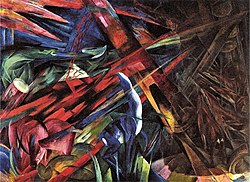
Back Modernisme Afrikaans Klassische Moderne ALS حركة حداثية Arabic تاعصرييت ARY حركه حداثيه ARZ আধুনিকতাবাদ Assamese Modernizm Azerbaijani مودرنیزم AZB Мадэрнізм Byelorussian Мадэрнізм BE-X-OLD



Modernism is an art movement together with a philosophical movement and a religious movement. It came from big changes in Western society during the late 19th and early 20th centuries.
Modernism was a cultural movement of the late 19th century to the mid-20th century. It was a philosophy and it was also an art movement. It changed art, literature, music, architecture and drama.[1]
Modernism rejected tradition. It was interested in new ways of doing old things. Also, there was a belief that science and technology could change the world for the better.[2]The term covers some movements which are somewhat contradictory.[3]
Some scholars think that modernism is (going on, or) continuing into the 21st century. Others see it (changing or) evolving into late modernism or high modernism.[4]
- ↑ Childs, Peter 2000. Modernism. Routledge, London.
- ↑ Hughes, Robert 1991. The shock of the new: art and the century of change. London: Thames & Hudson, p11. ISBN 978-0-500-27582-5
- ↑ Lewis, Pericles 2000, Modernism, nationalism, and the novel. Cambridge University Press.
- ↑ Morris Dickstein, "An Outsider to His Own Life", Books, The New York Times, August 3, 1997; Anthony Mellors, Late modernist poetics: From Pound to Prynne.